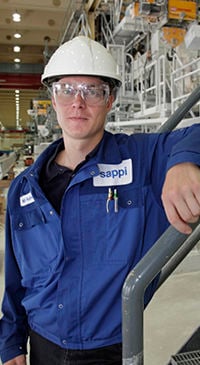Sappi Kirkniemi cuts coating machine (CM 3) drying costs
Dec 14, 2010

Operationally reliable air dryers are widely used for drying coating color, and use far less energy than infrared dryers. Their energy efficiency typically ranges from 70% to 75%, compared with 25% to 35% for infrared dryers. However, this already good efficiency can still be improved.
“Working together with Valmet we improved the energy efficiency of coating machine 3,” says Matti Korhonen, Assistant Process and Quality Manager.
Analyzing drying efficiency
Sappi’s Kirkniemi mill in Finland, which produces coated mechanical paper at the rate of 740,000 tpa, is continuously improving its energy efficiency. Thus, the mill’s management recently decided to study the drying energy consumption of coating machine 3 (CM 3), and chose Valmet to investigate potential savings and identify appropriate improvement solutions. All forms of energy flow (steam, gas and electricity) were addressed.
The analysis showed that the machinery was in good mechanical condition, and that the system was well operated in keeping with its original design. However, potential savings of 4.2 MW were discovered, and the following quick-payback measures were implemented:
- Use of air drying instead of IR drying
- Optimization of leakage and exhaust air flows
- Addition of heat recovery from air dryer exhaust air
| Energy Efficiency Analysis provides a systematic tool for energy savings projects. Valmet has carried out a large number of these analyses with good results. Energy savings of up to 20 percent have been identified even in well performing drying processes. Major benefits have often been achieved with minor investments, or simply by changing operating procedures. |
Savings through process optimization
The first notable savings were gained by optimizing the drying method. The infrared dryers at coating stations 1 and 2 were turned off and the use of air dryers was increased. These savings were based on the better energy efficiency of air dryers compared to infrared dryers. The mill achieved considerable further savings by increasing the dry content of the coating color in order to minimize water evaporation.
Improvement with a small investment
The next step was to install four compact heat recovery units for the air dryers of coating stations 1 and 2. These new heat recovery units are designed especially for air dryers and can be implemented with only a minor capital investment. The modular construction of the units suits all air dryer models, even those located in tight spaces in older mills. The air systems were additionally rebalanced during system start-up for optimal energy efficiency.
Efficiency measures continue
Now the optimization of energy usage is continuing at coating stations 3 and 4. There are often multiple possibilities for improving energy efficiency, and the key issue is to find the most profitable over the long term. “We have been very pleased with the results. We are now using close to 20% less gas-generated energy for drying coating than before,” says Matti Korhonen.